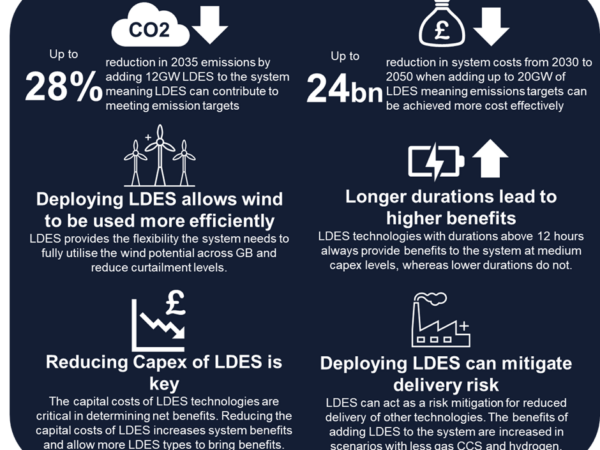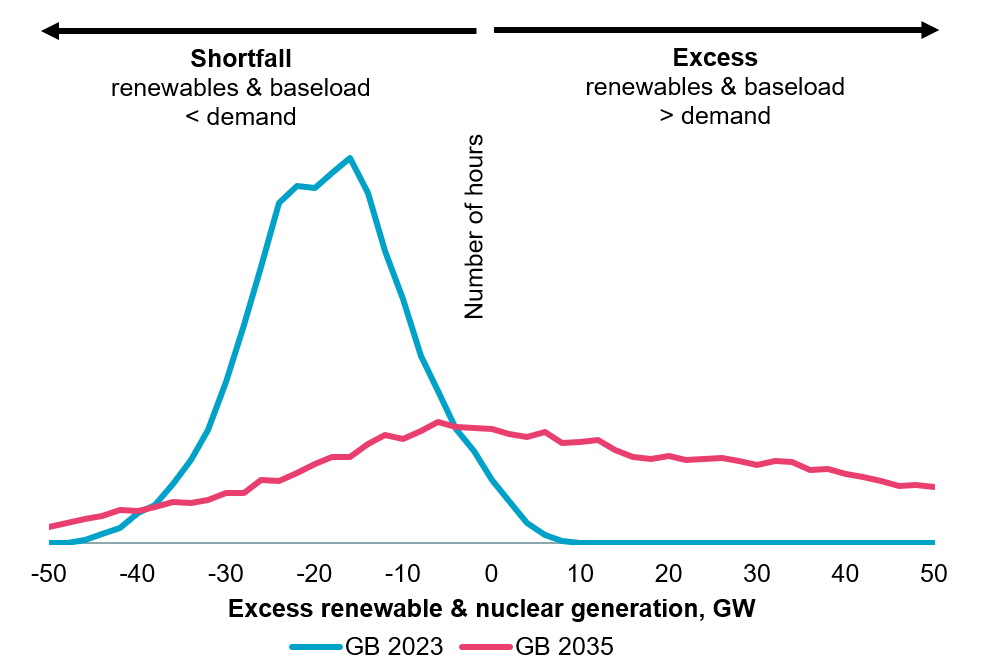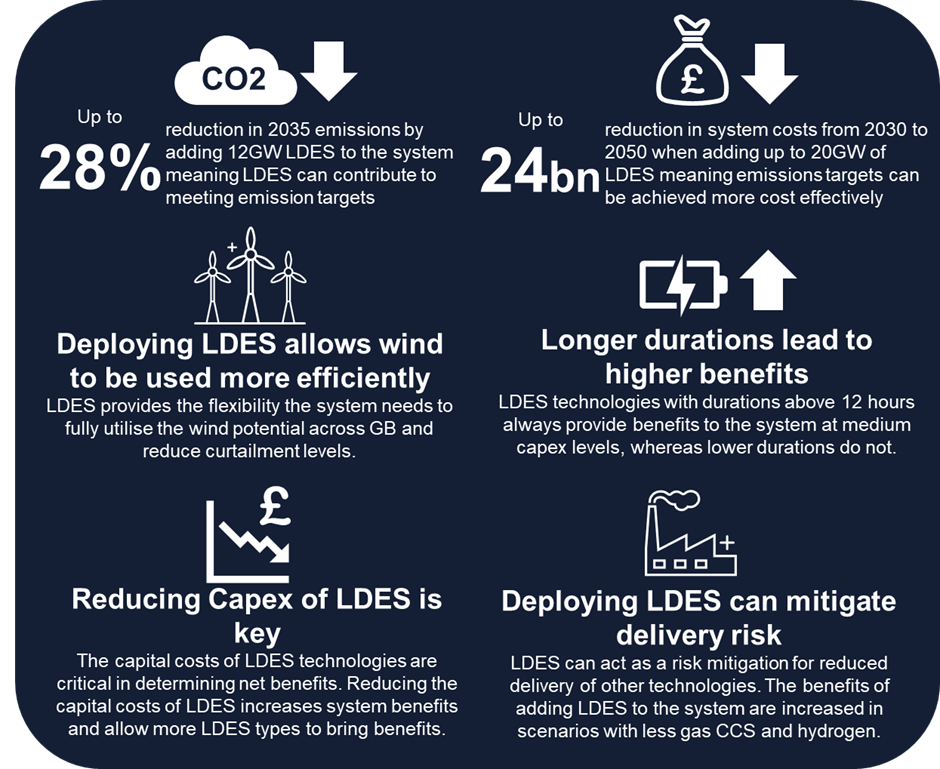The Department for Energy Security and Net Zero’s consultation on policy support for Long Duration Electricity Storage technologies, published today and backed by evidence provided by Regen and LCP Delta in a recent report, outlines the government’s intention to develop a cap and floor scheme for LDES technologies and seeks views on the recommended approach to developing the mechanism.

Our report, Scenario Deployment Analysis for Long-duration Electricity Storage, commissioned by the government and published alongside the consultation here, provides a comprehensive assessment of the role and impact of a range of LDES technologies on the future GB power system. This included engagement with leading UK storage technology and project developers and detailed modelling of the impact that different levels and types of LDES could have on the system.
Our report underscores the pivotal role of LDES in providing the necessary flexibility needed in the GB power system, driving a reduction in both emissions and system costs. It serves as a crucial evidence base for designing effective policies and market changes to support the deployment of these technologies, as the government has outlined in the current consultation.
The need for flexibility
Flexible technologies and sources of demand that can adjust their supply or demand quickly are crucial to the operation of the electricity system. As the power sector decarbonises and embraces more variable renewables, the need for low-carbon flexibility technologies becomes more paramount. Alongside a fast response, high-wind energy systems will have a need for longer duration flexibility, such as LDES, where wind patterns are likely to create extended periods of excess or shortfall power generation.
In 2023, before any flexibility is used, LCP Delta modelling shows we would expect around 14% of hours across the year to have excess levels of renewable and nuclear generation in GB. By 2035, based on DESNZ assumptions on the makeup of the future system, this could increase to 64% of hours. This can be seen in the chart below.

Wind generation can also exhibit significant volatility at a weekly/monthly scale where several days of high or low wind generation can follow in quick succession. This means the length of periods with excess renewable and nuclear generation could be significant, with periods of shortfall/excess lasting more than 24 hours and potentially several days. Analysis shows that, of GB’s total energy shortfalls/excess in 2035, over 50% of shortfall/excess events last more than 24 hours, while over 25% last more than 48 hours.
To manage this level of system imbalance requires technologies that are able to flex demand and supply over an extended period, while ensuring that the system continues to decarbonise. The main low-carbon options currently available include: interconnectors that can import or export energy, hydrogen that can be used as both a demand source for production and a fuel for power generation, and several forms of LDES, of which pumped-hydro is the most well established. A key question for the study is what role LDES can play.
Engaging with the sector provided useful insight into the roles and challenges for LDES
In the first stage of the study, Regen engaged with more than 25 storage technology developers, covering 11 storage technologies and including members of the Electricity Storage Network, to gather critical insights on the roles and capabilities of LDES.
The interviews and online survey covered views of the technical characteristics of different LDES technologies, their costs, and the risks and policy hurdles facing developers. Regen used its network and contacts gained from the management of the Electricity Storage Network, an industry group and voice for grid scale electricity storage in GB, to inform this work.
Several key findings emerged from this engagement:
- Developers see a need for reforms to existing markets and support for LDES to provide the appropriate incentives to get these technologies onto the system.
- LDES business models involve stacking various system services and revenue streams.
- Technical characteristics and capabilities vary across both technologies and individual projects.
- Developers are looking at a range of energy storage durations, ranging from several hours to days, to support different system needs.
- Reducing CapEx costs and cost of capital for LDES systems will be vital in getting LDES to market given the costs are highly variable and uncertain for these technologies.
Deploying LDES can provide a cheaper and more decarbonised power system
In the second stage of the project, LCP Delta conducted a detailed modelling exercise to assess the scale of LDES required in the GB power system up to 2050.
The analysis looked at the impact of LDES across a wide range of scenarios with more than 1,000 total scenarios modelled using LCP Delta’s in-house modelling expertise. The results from this analysis showed:
- Reduction in emissions: Integrating LDES into the GB power system can reduce power sector emissions by discharging stored renewable energy during peak/low wind periods instead of using gas. Our analysis shows that adding just 3GW of LDES in 2035 can further reduce emissions intensity of the power system by 3-8%, while adding 12GW of LDES can reduce emissions intensity by 10-28%.
- Reduction in system costs: Adding LDES to the system enables wind generation to be used more effectively – meaning the same level of emissions reduction to meet targets can be achieved with less investment in wind capacity. This allows for a reduction in system costs. Our analysis shows that deploying 20GW of LDES can save up to £24bn in power sector system costs (Net Present Value) from 2030 to 2050.
- LDES duration: Duration of LDES is the biggest factor in the size of the impact, with those longer duration technologies (up to 32 hours in scenarios tested) having the largest impact on emissions and system costs. We find that those with higher durations (16-32 hours) provide benefits with every additional GW of LDES added, while those with lower durations (12 hours or less) see their peak benefits at different points.
- CapEx costs: We tested the system cost impact with different levels of LDES CapEx, finding that the capital costs of LDES technologies are critical in determining the net benefits of LDES technologies. At high CapEx levels, some LDES technologies no longer reduce system costs, showing that reducing CapEx, particularly for nascent technologies, should be a priority.
- Mitigating delivery risk: LDES can act as a risk mitigation for reduced delivery of other technologies. With lower levels of gas CCS and hydrogen deployment, we find that there are greater emissions and system cost benefits when LDES is added to the system.

Regen and LCP Delta are firm supporters of the need for longer duration electricity storage, given the prevalence of wind in our future energy system. Both organisations have been working alongside industry to explore the commercial realities of investing in what is a high capex technology and ensuring a suitable policy environment. If you are interested in finding out more about our work, or how we are supporting clients in this space, please reach out.
The Electricity Storage Network, managed by Regen, is an industry group and voice for grid-scale electricity storage in GB. We have worked with our members and the wider industry as part of this report and analysis.
The full report and the consultation can be found on the government website here.
